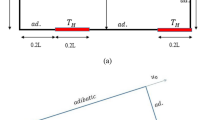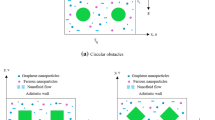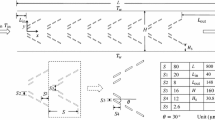Abstract
This research focuses on the flow and heat transfer characteristics past three hot obstacles in a sudden expansion and contraction channel. To enhance the heat transfer, the MWCNT-Fe3O4 Water hybrid nanofluid is used. The effect of Reynolds number (40, 70 and 100), nanoparticle volume fraction of MWCNT-Fe3O4/water hybrid nanofluid (0.00, 0.001, and 0.003) and different arrangements of discrete heat sources (47 arrangements) on the flow pattern, temperature distribution and heat transfer characteristics have been investigated. The lattice Boltzmann method (LBM) is applied for the simulations. It is found that the heat transport performance of each heated obstacle is not only related to its position and the arrangements of the other two heat sources are important. Compared with the other arrangements, when three obstacles are located on the first row, all three hot sources can obtain relatively better heat transfer performances, and the corresponding Nuave is 5.1451 which is 1.72 times the minimum value of Nuave (Case 4). The obstacle located behind another obstacle would obtain low Nuavg. Besides, to achieve the highest heat transfer performance of one heat obstacle in a column, the position OBS#4 in Case 14 needs to be placed.












Similar content being viewed by others
Abbreviations
- H :
-
Height of the channel
- ei:
-
Discrete lattice velocity in direction
- f :
-
Density distribution function
- feq:
-
Equilibrium density distribution function
- Nu:
-
Nusselt number
- U, V:
-
Non-dimensional velocity components
- Pr:
-
Prandtl number
- L:
-
Width of the channel
- cs:
-
Sound speed in Lattice scale
- g :
-
Energy distribution function
- geq:
-
Equilibrium energy distribution function
- T :
-
Fluid temperature
- k :
-
Thermal conductivity
- Re:
-
Reynolds number
- ωi:
-
Mass function in i direction
- ϕ :
-
Volume fraction
- τc:
-
Relaxation time for temperature
- α :
-
Thermal diffusivity
- ρ :
-
Density
- τv:
-
Relaxation time for fluid flow
- β :
-
Thermal expansion coefficient
- μ :
-
Dynamic viscosity
- p :
-
Solid particles
- nf:
-
Nanofluid
- c :
-
Cold
- f :
-
Fluid
- h :
-
Hot
- i :
-
Moving direction of single-particle
References
Mohebbi R, Rashidi MM. Numerical simulation of natural convection heat transfer of a nanofluid in an L-shaped enclosure with a heating obstacle. J Taiwan Inst Chem Eng. 2017;72:70–84.
Dehghan M, Vajedi H, Daneshipour M, Pourrajabian A, Rahgozar S, Ilis GG. Pumping power and heat transfer rate of converging microchannel heat sinks: errors associated with the temperature dependency of nanofluids. J Therm Anal Calorim. 2020;140(3):1267–75.
Mohebbi R, Lakzayi H, Sidik NAC, Japar WMAA. Lattice Boltzmann method based study of the heat transfer augmentation associated with Cu/water nanofluid in a channel with surface mounted blocks. Int J Heat Mass Transf. 2018;117:425–35.
Mohebbi R, Rashidi MM, Izadi M, Sidik NAC, Xian HW. Forced convection of nanofluids in an extended surfaces channel using lattice Boltzmann method. Int J Heat Mass Transf. 2018;117:1291–303.
Mohebbi R, Haghighi Khalilabad S, Ma Y. Effect of γ-Al2O3/water nanofluid on natural convection heat transfer of corrugated ⅂ shaped cavity: study the different aspect ratio of grooves. J Appl Fluid Mech. 2019;12(4):1151–60.
Ma Y, Mohebbi R, Rashidi MM, Yang Z. MHD convective heat transfer of Ag-MgO/water hybrid nanofluid in a channel with active heaters and coolers. Int J Heat Mass Transf. 2019;137:714–26.
Mohebbi R, Izadi M, Amiri Delouei A, Sajjadi H. Effect of MWCNT-Fe3O4/water hybrid nanofluid on the thermal performance of ribbed channel with apart sections of heating and cooling. J Therm Anal Calorim. 2019;135(6):3029–42.
Liu Y, Phan-Thien N. An optimum spacing program for three chips mounted on a vertical substrate in an enclosure. Heat Transf Part A. 2000;37:613–30.
Queipo N, Devarakonda R, Humphery ACJ. Genetic algorithms for thermosciences research: application to the optimized cooling of electronic components. Int J Heat Mass Transf. 1994;37:893–908.
Chen S, Liu Y. An optimum spacing problem for three-by-three heated elements mounted on a substrate. Heat Mass Transf. 2002;29:3–9.
da Silva AK, Lorente S, Bejan A. Optimal distribution of discrete heat sources on a plate with laminar forced convection. Int J Heat Mass Transf. 2004;47:2139–48.
Dias T, Milanez LF. Optimal location of heat sources on a vertical wall with natural convection through genetic algorithms. Int J Heat Mass Transf. 2006;49:2090–6.
Sudhakar TVV, Balaji C, Venkateshan SP. Optimal configuration of discrete heat sources in a vertical duct under conjugate mixed convection using artificial neural networks. Int J Therm Sci. 2009;48:881–90.
Rahimi A, Sepehr M, Janghorban Lariche M, Mesbah M, Kasaeipoor A, Hasani Malekshah E. Analysis of natural convection in nanofluid-filled H-shaped cavity by entropy generation and heatline visualization using lattice Boltzmann method. Phys E. 2018;97:347–62.
Sarper B, Saglam M, Aydin O. Experimental and numerical investigation of natural convection in a discretely heated vertical channel: Effect of the blockage ratio of the heat sources. Int J Heat Mass Transf. 2018;126:894–910.
Selimefendigil F, Öztop HF. Effects of local curvature and magnetic field on forced convection in a layered partly porous channel with area expansion. Int J Mech Sci. 2020;179:10569.
Hajji H, Kolsi L, Ghachem K, Maatki C, Hussein AK, Borjini MN. Numerical study of heat transfer and flow structure over a microscale backstep. Alex Eng J. 2021;60(3):2759–68.
Agrawal A, Djenidi L, Antonia RA. Simulation of gas flow in microchannels with a sudden expansion or contraction. J Fluid Mech. 2005;530:135–44.
Nouri D, Pasandideh-Fard M, Oboodi MJ, Mahian O, Sahin AZ. Entropy generation analysis of nanofluid flow over a spherical heat source inside a channel with sudden expansion and contraction. Int J Heat Mass Transf. 2018;1(116):1036–43.
Sebdani SM, Mahmoodi M, Hashemi SM. Effect of nanofluid variable properties on mixed convection in a square cavity. Int J Therm Sci. 2012;52:112–26.
Frisch U, Hasslacher B, Pomeau Y. Lattice-gas automata for the Navier-Stokes equation. Phys Rev Lett. 1986;56(14):1505.
Frisch U. Relation between the lattice Boltzmann equation and the Navier-Stokes equations. Phys D. 1991;47(1–2):231–2.
McNamara GR, Zanetti G. Use of the Boltzmann equation to simulate lattice-gas automata. Phys Rev Lett. 1988;61(20):2332.
Higuera FJ. Boltzmann approach to lattice gas simulations. EPL. 1989;9(7):663.
Chen H, Chen S, Matthaeus WH. Recovery of the Navier-Stokes equations using a lattice-gas Boltzmann method. Phys Rev A. 1992;45(8):R5339.
Narendran G, Perumal DA, Gnanasekeran N. A review of lattice boltzmann method computational domains for micro-and nanoregime applications. Nanosci Technol Int J. 2020;11(4).
Zou Q, He X. On pressure and velocity boundary conditions for the lattice Boltzmann BGK model. Phys Fluids. 1997;9:1591–8.
Mohamad AA. Lattice boltzmann method. New York: Springer; 2011.
Mohebbi R, Rashidi MM, Izadi M, Sidik NAC, Xian HW. Forced convection of nanofluids in an extended surfaces channel using lattice Boltzmann method. Int J Heat Mass Transf. 2018;117:1291–303.
Acknowledgements
The Financial Support of the Research Council of Damghan University with the Grant number 98/eng/134/327 is acknowledged.
Author information
Authors and Affiliations
Corresponding author
Additional information
Publisher's Note
Springer Nature remains neutral with regard to jurisdictional claims in published maps and institutional affiliations.
Rights and permissions
Springer Nature or its licensor (e.g. a society or other partner) holds exclusive rights to this article under a publishing agreement with the author(s) or other rightsholder(s); author self-archiving of the accepted manuscript version of this article is solely governed by the terms of such publishing agreement and applicable law.
About this article
Cite this article
Mohebbi, R., Ma, Y. Optimal configuration of discrete heat sources in a channel with sudden expansion and contraction by lattice Boltzmann method. J Therm Anal Calorim 148, 4553–4566 (2023). https://doi.org/10.1007/s10973-023-12020-8
Received:
Accepted:
Published:
Issue Date:
DOI: https://doi.org/10.1007/s10973-023-12020-8




